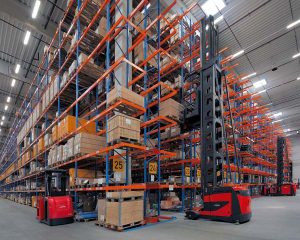If you’ve ever heard the saying “a place for everything and everything in its place,” you understand the importance of optimizing warehouse layout and design. When it comes to efficient narrow aisle forklift use, every inch of space matters. By carefully planning the layout and design of your warehouse, you can maximize storage capacity, improve forklift maneuverability, and enhance overall productivity. From aisle width considerations to ergonomic design for operator efficiency, every aspect plays a crucial role in creating a streamlined and effective warehouse environment. Safety measures and best practices also need to be integrated into the layout and design to ensure a secure and efficient operation. Let’s explore the key elements of optimizing your warehouse for narrow aisle forklift use.

Space Utilization and Storage Capacity
To optimize space utilization and storage capacity in your warehouse, consider the strategic placement of racks and shelving to maximize efficiency and accessibility for narrow aisle forklift use. By arranging your storage units with narrow aisles in mind, you can significantly increase the amount of inventory that can be housed within the same square footage. Utilize tall, sturdy shelving units to take advantage of vertical space, allowing for more items to be stored without expanding the floor area. Additionally, implementing specialized racking systems designed for narrow aisle forklifts can further enhance storage capacity. These adjustments not only optimize the use of available space but also improve the overall efficiency of your warehouse operations, allowing for smoother and more streamlined processes.
Aisle Width and Layout Considerations
Considering the operational efficiency and maneuverability of your narrow aisle forklift, it is essential to carefully evaluate aisle width and layout considerations in your warehouse design. The aisle width directly impacts the forklift’s ability to navigate through the warehouse. Narrow aisles maximize storage space but require specialized forklifts, while wider aisles accommodate various forklift types but may reduce overall storage capacity. Additionally, the layout should prioritize efficient traffic flow and minimize congestion points. Utilizing techniques such as diagonal slotting or strategic product placement can optimize aisle space and enhance forklift maneuverability. Proper aisle width and layout design can significantly impact overall warehouse productivity, making it crucial to assess these factors when planning or reconfiguring your warehouse space.
Ergonomic Design for Operator Efficiency
When designing the warehouse layout for efficient narrow aisle forklift use, prioritize ergonomic design to enhance operator efficiency. Ensure that the forklift controls are within easy reach and that the operator’s seat is adjustable for comfort. Implement anti-fatigue mats to reduce the strain of standing for extended periods. Additionally, provide clear visibility by strategically placing mirrors and ensuring adequate lighting throughout the warehouse. Minimize the need for repetitive bending and reaching by organizing storage areas with easy access in mind. Consider incorporating automated features, such as adjustable forks and lifting mechanisms, to reduce physical strain on the operator. By focusing on ergonomic design, you can create a workspace that promotes operator comfort, reduces the risk of injury, and ultimately enhances efficiency.
Safety Measures and Best Practices
Ensure that the warehouse layout and design prioritize safety measures and best practices to create a secure and efficient environment for narrow aisle forklift operation. Implement clear aisle markings, proper lighting, and signage to enhance visibility and reduce the risk of accidents. Utilize safety barriers and designated pedestrian walkways to separate forklift traffic from foot traffic, minimizing the chances of collisions. Regularly inspect and maintain equipment to ensure optimal functionality and prevent malfunctions that could compromise safety. Provide comprehensive training for forklift operators, emphasizing safe operating procedures, load handling techniques, and awareness of their surroundings. Encourage a culture of safety awareness and responsibility among all warehouse staff. By consistently adhering to these safety measures and best practices, you can significantly reduce the potential for accidents and create a secure working environment for narrow aisle forklift operations.